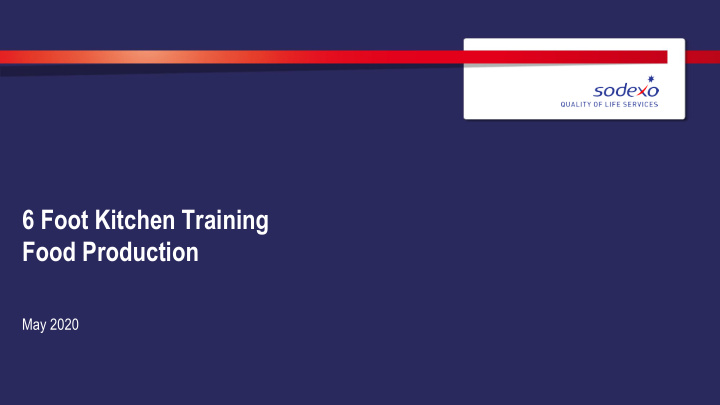



6 Foot Kitchen Training Food Production May 2020
Food Production (60 minutes) LEARNING OUTCOMES: After this Topic, learners will have an understanding of: Module I: 10 minutes How to properly take the temperature of team members as they § arrive for work. Module II: 10 Minutes The importance of keeping your distance. § Module III: 10 minutes Why the receiving person is the only one allowed in storage areas. § Module IV: 10 minutes How to properly thaw frozen food for production. § Module V: 10 minutes The importance of food safety inspections § Quiz: 10 Minutes
Module I How to properly take the temperature of team members (10 minutes) § Taking temperatures is safest with a non- contact thermometer like a handheld infrared seen here. § Point the thermometer at the forehead. § Hold it about two inches from the forehead. § A healthy person will have a temperature of 98.6 Fahrenheit or 37 degrees Celsius. § If your temperature is 100.4 F or more you should stay home.
Module II Keep Your Distance (10 minutes) • When workers are too close together the possibility of infection is increased. • Spreading out the work over a longer period of time keeps fewer people in the kitchen at the same time. • Prep can be done overnight or early morning and supplies can be stocked in work stations before production crew arrives. • Using the cooking stations for prep helps spread out the workforce. • Mark a six foot semi circle on the floor around each work station and directional arrows.
Module III Why the receiving person is the only one allowed in storage. (10 minutes) • The receiving person’s duties. • Why it is important to only have one person in any of the storage areas. • How to reduce the possibility of cross contamination by reducing the number of people touching anything. • The importance of cleaning and sanitizing. • How to reduce the spread of disease by decreasing the number of touches any items have. • Why it is important to, wherever possible, prop doors open to reduce the chance of anyone having to touch a door handle or knob.
Module IV How to properly thaw frozen food (10 minutes) • How to thaw food under refrigeration. The best and preferred method for the best quality product. • How to thaw food in a microwave oven. • How to thaw food as part of the cooking process. • How to thaw food under cold running water. The least preferred method.
Module V The importance of Food Safety Inspections (15 minutes) § The importance of keeping all inspection logs up to date including, refrigerator, freezer, sanitizer solution, warming cabinets, dishwashers and receiving. § What the weekly self inspection is and what it covers. § What the monthly self-inspection is and what it covers. § What the annual “Comprehensive Food Safety Self-Inspection” is and what it covers. § What other food safety materials are available and where to find them.
QUIZ 1. What is the proper temperature of a healthy person (in Fahrenheit)? a. 98.6 degrees if you have a temperature of 100.4 F or above you should stay home. 2. How can changing the work schedule help reduce the chances of someone becoming infected? a. By spreading out the work fewer people will be in the kitchen at the same time. 3. What is the best method for thawing out frozen food? a. Under refrigeration. 4. Why would we prop open internal doors in the kitchen? a. To reduce the number of times different people touch door handles or knobs thus reducing the chances of cross contamination 5. How often should a Comprehensive Food Safety Self Inspection be conducted? a. Annually
REMEMBE R
APPENDIX
Recommend
More recommend